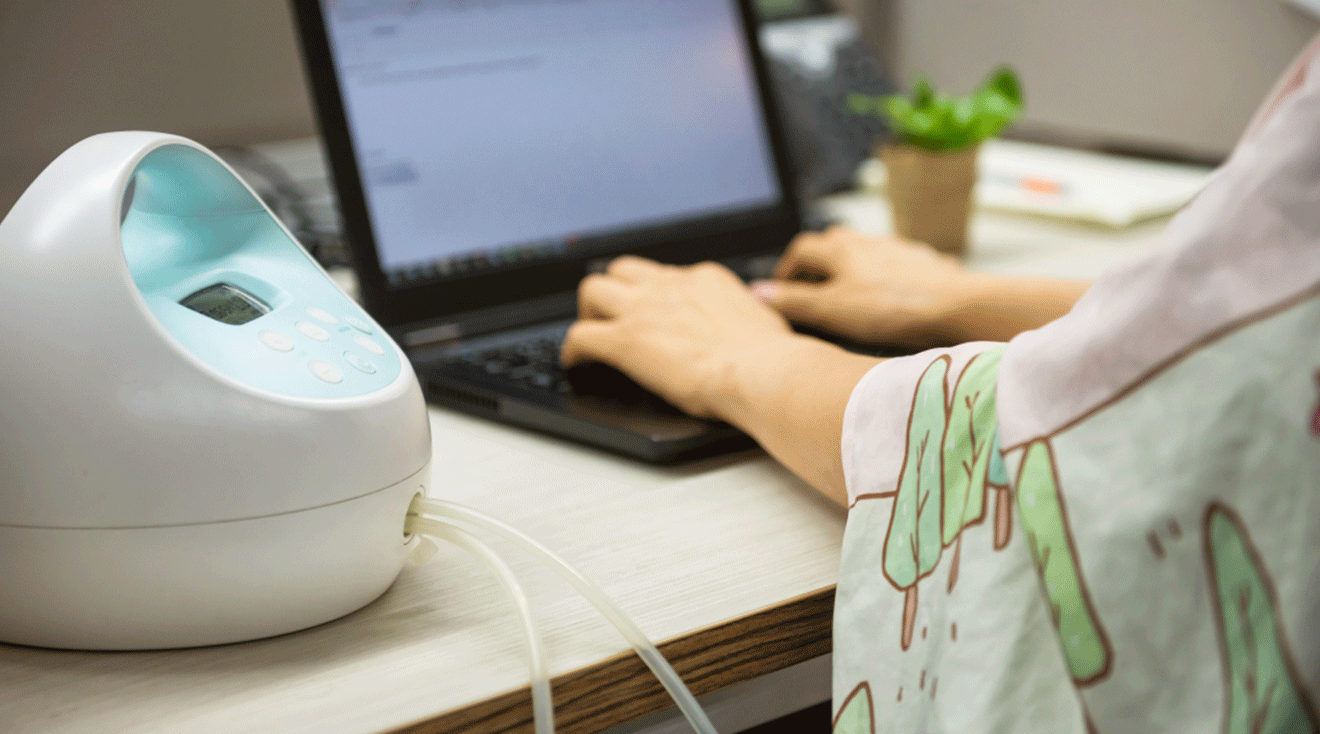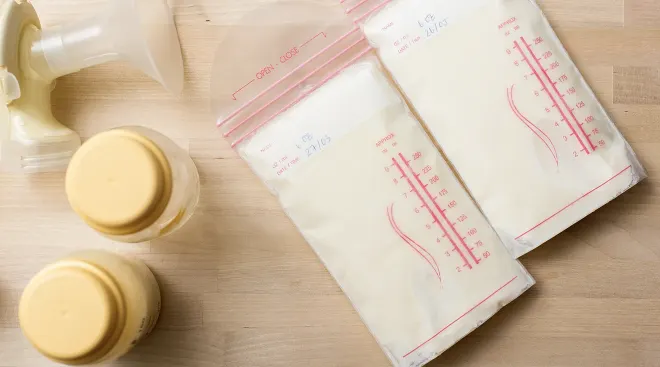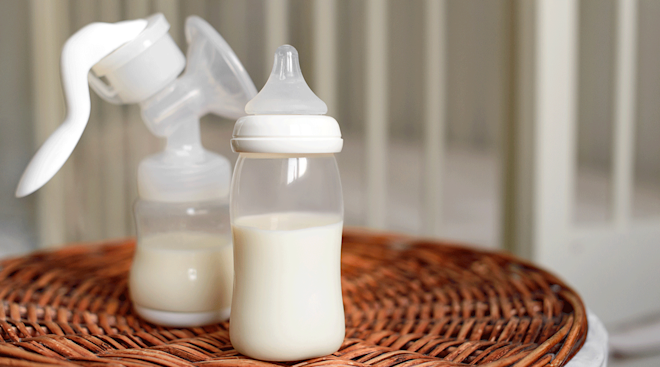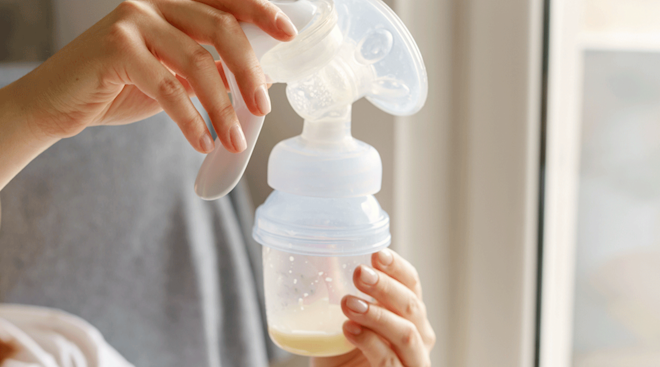11 Tips for Pumping at Work
If you’re one of the more than 50 percent of women returning to work in the first three months after giving birth, you’ve probably had to consider pumping on the job. At 3 months old, baby is still totally dependent on milk, so unless you’re planning to switch to formula during your working hours—or wean them completely before you go back to work—you’ll have to figure out how to pump during your day job and bring all that liquid gold home to baby for bottle feeding.
But the logistics of juggling everyday job responsibilities and frequent pumping breaks are complicated, to say the least. How will you transport all your supplies back and forth? Will you have to pump in the employee bathroom (gag)? Where will you store all your milk? Not to mention the dreaded negotiations with your employer. (While the Fair Labor Standards Act (FLSA) says the majority of US workers have a right to pump at work as often as they need to, having those conversations with your boss can be awkward, especially if they’re less than 100 percent supportive.)
The good news is there are lots of things you can do to make pumping at work a bit easier, from making a plan with your employer way in advance to streamlining your supplies to choosing the best on-the-go breast pump. Here are 11 tips to set yourself up for success when pumping at work.
If you’re hesitant about breastfeeding or unsure if you want to pump at work, you might think it’s better to wait and see how things go during your maternity leave before talking to your employer. But even if you’re only considering pumping at work, you should have that convo sooner than later.
“Prior to your maternity leave, notify your employer about your desire to breastfeed and [talk about] your pumping needs, so they can get an area ready and [plan to] provide you with the necessary time and resources,” advises Mona Amin, DO, IBCLC, a pediatrician and the host of the PedsDocTalk Podcast.
If your employer needs a little convincing, Julie Brill, IBCLC, CCCE, CLD, a lactation consultant practicing in Massachusetts, says you can share that lactating parents typically miss less work than parents of formula-fed infants because their babies are sick less often, a fact supported by the Office on Women’s Health in their breakdown of breastfeeding health benefits.
Keep in mind, though, that you shouldn’t need to cajole your employer into “agreeing” to your plan—you have a right to pump at work, so try to be confident. Amin suggests approaching the conversation in a direct but respectful way, clearly stating your expected pumping needs and proposing professional solutions on how you will be accommodated without disrupting your work. If necessary, contact your employer’s HR department (if you have one) for assistance talking to your boss.
The FLSA requires the vast majority of employers—including small businesses and non-profit organizations—to give nursing moms as many pumping breaks as they need for one year after their child’s birth. That amount can change based on how old baby is, how much breast milk they need or how often you need to pump for your comfort and milk supply maintenance.
Originally, the FLSA covered many US employees but not all; some teachers, nurses, agricultural workers and more could be excluded. However, a 2022 follow-up law, the Providing Urgent Maternal Protections (PUMP) for Nursing Mothers Act, extended that coverage to nearly every employee except for a rare few (primarily airline crewmembers like flight attendants and pilots). Chances are, you are covered by the [PUMP Act](https://www.usbreastfeeding.org/the-pump-act-explained.html#:~:text=Unfortunately%2C airline flight crewmembers (flight,as employees in other industries), and that means your employer needs to give you time to pump at work.
It also means your employer needs to give you an appropriate space to pump. That space cannot be a bathroom, and it should meet other basic requirements, too: it should be private, (i.e. not out in the open or subject to the intrusion of coworkers), and available for you to use whenever you need it.
Calculate how much milk you’ll need to pump each day based on baby’s needs. Many parents make the mistake of thinking they need a big freezer stash of breast milk in order to go back to work, says Brill, but you really only need enough for the first day you’ll be away and a little extra for your own peace of mind. After that, the milk you pump at work can go straight home with you to be your baby’s food for the next day.
As for how much milk you need to pump, it’s highly dependent on baby’s age and appetite, but Brill says most breastfed babies who are at least a month old need between 1 and 1.5 ounces for every hour you’re away. If you have a 10-hour day between working hours and commuting time, Brill recommends setting a pumping goal of 10 to 15 ounces of milk.
If you’re looking to narrow down your breast pump options before choosing one, start by thinking about what will work best in the space being provided to you. A hospital-grade pump is ideal, says Leigh Anne O’Connor, IBCLC, a New York City-based lactation consultant. If you need to commute back and forth with your pump every day, you might want to opt for a smaller, more lightweight option.
The pump you choose should be efficient, portable, quiet and easy to use and clean, says Amin. One other critical consideration? The power source. If you won’t have access to an outlet, you’ll need a pump that’s battery-operated. Also think about whether a wearable or hands-free pump would be beneficial for you. If you have a private office and are hoping to pump while you’re working, a hands-free option will allow you to get the job done while you send off emails or make phone calls.
Unfortunately, pumping on the go isn’t quite as easy as it is at home, since you’ll need to have a handful of cleaning supplies and equipment parts, plus a way to store everything when it’s not in use or being transported from place to place.
All three experts we spoke to recommended some combination of the following items (though you should feel free to pick and choose only the ones you need for your specific workspace):
- Breast pump and all necessary parts like tubing, flanges and valves
- Pump charger or extra batteries
- Bottles or milk storage bags
- Labels and/or marker
- Insulated cooler bag and ice packs (if there’s no on-site refrigerator and/or you have a long commute home)
- Cleaning supplies, like dish soap and brush or disinfecting wipes (alternatively, you can have multiple sets of pump parts and a bag to store used parts until they can be cleaned at home)
At home, you may be used to pumping and leaving breast milk out until baby’s next bottle in a few hours, but at work you’ll need to consider how to safely store your milk until you get home.
“Your breast milk can be kept at room temperature (77 degrees Fahrenheit) for up to four hours,” says Amin, “and in the refrigerator (at 40 degrees Fahrenheit or lower) for up to four days.”
Any milk not used within four days should be frozen, per Centers of Disease Control and Prevention (CDC) guidelines; it can be remain stored there for up to 12 months (though it’s best to use it within six months).Once it’s thawed in the refrigerator, you’ll want to use within 24 hours. Also make sure you wash your hands before pumping to reduce any contamination of your pump parts.
Whether your employer gives you a partitioned corner of a break room, an office with a lock or a fancy nursing pod to pump in, it helps to make this space as comfortable and quiet as possible. The let down mechanism that allows your milk to begin flowing is triggered by the feel-good hormone oxytocin, so pumping at work will be easier and more productive if you can get into the right headspace when you start. Amin says it might help to have a picture of baby with you to trigger your milk-ejection reflex.
Finding clothing that’s both appropriate for your work environment and nursing-friendly might be one of the most challenging parts about pumping at work. It also may not be possible: if you’re required to wear a certain uniform at work, you may not be able to modify it for easy access when it’s time to pump. In those cases, make sure your pumping space is private and wear a nursing bra to make it more convenient.
If you have more say in what you wear to work, choose separates (i.e. a top and bottom) as much as possible. Loose, flowy tops or button-down blouses give you the most flexibility for pumping underneath your clothes.
Pumping at work can be challenging, especially in the beginning. Expect some difficulties and plan to be patient and flexible as you and your employer work through some of the kinks.
“The biggest reason I see milk supply reduce when a mom goes back to work is the stress and inability to maintain a pumping schedule,” says Amin. “If you’re running behind, don’t let it consume you: the goal is to maintain a schedule [while] understanding that things happen, and pump as close to your schedule as possible.”
Your milk production is closely tied to your own nutrition—in fact, according to the Academy of Nutrition and Dietetics, breastfeeding moms need about 16 cups of water per day to maintain their supply. They recommend drinking a large glass of water every time you sit down to breastfeed or pump.
It’s also important to get the right caloric intake: the CDC recommends breastfeeding moms get an additional 340 to 400 calories per day, so try not to skip meals while you’re at work. You can also keep a stash of nutritious snacks in your pumping space in case you fall behind.
If you’re having trouble pumping or maintaining your milk supply at work, Amin suggests reaching out to a certified lactation consultant so you have a supportive person in your corner as you figure out how to juggle pumping alongside your job. A lactation consultant can help you set a pumping schedule that works for you while providing enough milk for baby. They can also advise you on the best breast pump and accessories for your body so pumping is as comfortable and effective as possible
If you’re not exclusively pumping, O’Connor says it’s important to keep building your breastfeeding relationship with baby when you’re not at work by nursing at home rather than giving bottles. This will also help maintain your milk supply, per Nationwide Children’s.
Is pumping at work a challenge? Yes, but you’ve given birth to a human being before, so you’re up for it! Tackling your work responsibilities while setting aside time for pumping breaks requires preparation, communication and flexibility. Don’t hesitate to talk to your employer’s HR department, if you have one, or get a lactation consultant on board to help you plan ahead. Just remember that it’s your right to pump at work. It’s not a matter of whether or not you can pump at work, only how best to make it happen.
Please note: The Bump and the materials and information it contains are not intended to, and do not constitute, medical or other health advice or diagnosis and should not be used as such. You should always consult with a qualified physician or health professional about your specific circumstances.
Plus, more from The Bump:
Mona Amin, DO, IBCLC, is a pediatrician, lactation consultant and Philips Avent partner. She si also the host of the PedsDocTalk Podcast. She earned her medical degree from ATSU-SOMA in Arizona.
Julie Brill, IBCLC, CCCE, CLD, is a lactation consultant and doula practicing in Massachusetts.
Leigh Anne O’Connor, IBCLC, is a New York City-based lactation consultant.
Safety and Health at Work, Work Reentry After Childbirth: Predictors of Self-Rated Health in Month One Among a Sample of University Faculty and Staff, 2019 US Department of Labor, FLSA Protections to Pump at Work
Office on Women’s Health, What employers need to know
US Breastfeeding Committee, The PUMP Act Explained
Centers for Disease Control and Prevention (CDC), Breast Milk Storage and Preparation
Academy of Nutrition and Dietetics, Nursing Your Baby — What You Eat and Drink Matters
Centers for Disease Control and Prevention (CDC), Maternal Diet and Breastfeeding
Nationwide Children’s, Breastfeeding When Returning to Work
Learn how we ensure the accuracy of our content through our editorial and medical review process.
Navigate forward to interact with the calendar and select a date. Press the question mark key to get the keyboard shortcuts for changing dates.





















































